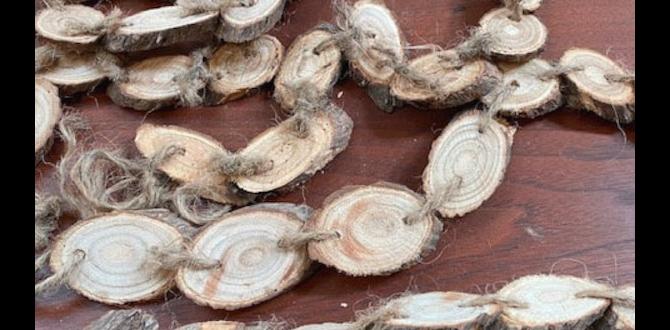Quick Summary: Mastering how to use a finish nailer for window trim involves selecting the right nailer and nails, understanding depth setting, and firing nails at a slight angle into studs for a secure, professional finish. This guide makes it easy for beginners.
Adding attractive window trim can really brighten up a room. But getting that trim perfectly in place, especially with nails, can feel a bit daunting. You want it to look neat and professional, not like a DIY disaster. Fortunately, using a finish nailer makes this job much simpler and faster for DIYers. It’s the secret weapon for a clean, sharp look on your window projects. We’ll walk you through everything you need to know, step-by-step, so you can nail this project with confidence.
Table of Contents
Why a Finish Nailer is Your Best Friend for Window Trim
Window trim is all about precision and appearance. You need to fasten pieces of wood securely without marring the surface or having nails stick out. This is where a finish nailer shines. Unlike a framing nailer, which uses much larger nails for structural work, a finish nailer drives slimmer, shorter nails. These nails are less likely to split the wood, especially delicate trim pieces, and leave smaller holes that are easy to fill and hide. This means a much cleaner, more professional result with less frustration.
Using a finish nailer also speeds up the process significantly compared to hammering. Instead of each nail being a deliberate, precise effort, you can drive them quickly and consistently. This is a huge time-saver, especially when you have multiple windows to trim out.
Choosing the Right Finish Nailer and Supplies

Before you start, let’s make sure you have the right tools for the job. Picking the correct finish nailer and accessories is key to a smooth experience.
Types of Finish Nailers
There are a few main power sources for finish nailers, each with its own pros and cons:
- Pneumatic Finish Nailers: These are the most common type. They require an air compressor and an air hose.
- Pros: Generally lighter in weight, powerful, reliable, and less expensive upfront than other types. They offer consistent performance.
- Cons: Requires an air compressor, which can be bulky and noisy. You also have to manage the air hose, which can sometimes get in the way.
- Cordless Battery-Powered Finish Nailers: These use a rechargeable battery and often have a small, integrated air pump or a gas cartridge system.
- Pros: Complete freedom of movement – no cords, no hoses! Great for portability and quick jobs.
- Cons: Can be heavier due to the battery, often more expensive initially, and battery life needs to be considered. Some models might be less powerful than pneumatic versions.
- Cordless Gas/Fuel Cell Finish Nailers: These use a fuel cartridge and a battery to ignite the fuel, driving the nail.
- Pros: Very portable, often powerful, and can drive nails quickly.
- Cons: Require replacement fuel cartridges (an ongoing cost), can produce fumes, and some people dislike the smell. Performance can be affected by temperature.
What to Look For in a Finish Nailer for Trim
For window trim, you’ll want a nailer that can handle typically 15-gauge or 16-gauge nails. These provide enough holding power without being overkill.
- Gauge: 15-gauge (also called “field” nails) are slightly thicker and offer more holding power. 16-gauge (“))$.”) nails are thinner, leave smaller holes, and are great for delicate trim or tight corners where splitting is a concern. For most standard window trim, either will work well, but 16-gauge is often preferred for its minimal marring.
- Nail Length: You’ll need nails long enough to go through your trim and securely into the window frame or wall studs. Typically, 1-1/4 inch to 2-1/2 inch nails are suitable for trim work. Check the thickness of your trim and the material behind it. A good rule of thumb is to have the nail penetrate about 3/4 of an inch into the framing material (like a stud).
- Depth Adjustment: This is crucial! You need to be able to control how deep the nail drives. You want it to sink just below the surface of the trim so you can fill the hole easily, but not so deep that it blows through the other side or creates a large divot.
- Jam Clearing Mechanism: Jams happen, especially with new users. A tool-free jam release makes it quick and easy to clear a stuck nail without needing extra tools.
- Ergonomics: Since you might be holding the tool for a while, make sure it feels comfortable and balanced in your hand.
Essential Supplies Beyond the Nailer
Here’s a checklist of what else you’ll need:
- Nailer-Specific Nails: Only use nails designed for your specific nailer and gauge.
- Air Compressor & Hose (if using pneumatic): Ensure your compressor is adequate for the nailer’s needs and the hose is long enough.
- Rechargeable Batteries & Charger (if cordless): Make sure they are fully charged.
- Safety Glasses: Absolutely non-negotiable. Always protect your eyes.
- Hearing Protection: Nailers can be loud; protect your hearing during prolonged use.
- Work Gloves: For grip and to protect your hands.
- Trim Material: Your chosen window trim.
- Measuring Tape & Pencil: For precise measurements.
- Miter Saw or Hand Saw: For cutting trim to size.
- Stud Finder: To locate studs for secure nailing.
- Wood Glue: For strengthening joints and the back of trim pieces.
- Putty Knife & Wood Filler/Wood Dough: For filling nail holes.
- Sanding Block & Sandpaper: For smoothing filler and the trim.
- Caulk: For sealing gaps.
- Paint or Stain: For finishing.
Step-by-Step: How to Use a Finish Nailer for Window Trim
Now that you have your tools and supplies, let’s get this trim installed. We’ll break it down into manageable steps.
Step 1: Prepare Your Workspace and Materials
Before you fire up the nailer, some prep work is essential:
- Clean the Area: Make sure the area around the window is clear of debris and obstacles.
- Measure and Cut Trim: Carefully measure the sides, top, and bottom of your window opening. Use a miter saw to cut your trim pieces to the correct lengths and angles (usually 45-degree miters for the corners). Test fit each piece to ensure it sits flush against the wall and window frame. A snug fit is key!
- Pre-Drill (Optional but Recommended): For very hard woods or if you’re concerned about splitting, you might consider pre-drilling pilot holes slightly smaller than the nail diameter. However, with the correct gauge and careful firing, this is often not necessary with a finish nailer.
- Apply Wood Glue: For stronger joints, apply a thin bead of wood glue to the mitered ends where trim pieces will meet. You’ll also want to apply a bead of glue to the back of the trim piece where it will contact the wall/window frame. The nails will hold it while the glue dries.
Step 2: Set Up Your Finish Nailer
This is where you fine-tune the tool for optimal performance.
- Connect Power:
- Pneumatic: Connect your air hose from the compressor to the nailer. Ensure the compressor is turned on and has reached its operating pressure.
- Cordless: Ensure your battery is charged and properly seated.
- Gas: Insert a fresh fuel cartridge and battery as per the manufacturer’s instructions.
- Load the Nails: Open the nailer’s magazine according to the manufacturer’s instructions and load the correct gauge and length of nails. Make sure they are seated properly.
- Adjust Depth Setting: This is CRITICAL for a clean finish.
- Test Firing: Find a scrap piece of the same trim material you’re using.
- Set the Depth: Adjust the depth setting on your nailer. Start with a medium setting. Fire a nail into the scrap. If the nail head pops out, increase the depth. If the nail sinks too deep and creates a crater, decrease the depth. The goal is for the nail head to be just slightly below the surface of the wood, ready to be filled.
- Consider Material: Softer woods might require a shallower setting, while harder woods might need a slightly deeper setting.
- Set Air Pressure (Pneumatic): If you’re using a pneumatic nailer, set the air pressure according to your nailer’s manual. Generally, 70-100 PSI is a common range for finish nailers. Too little pressure won’t drive the nail fully; too much can damage the wood or cause the nail to overdrive.
Step 3: Locate Studs for Secure Nailing
While trim can be nailed directly into a window frame, for maximum security (and to prevent gaps from opening up over time), you want to drive some nails into the wall studs behind the trim. Trim needs to be held firmly not just to the frame, but to the solid structure of the wall.
- Use a stud finder to locate the vertical studs surrounding your window opening. Mark their approximate locations lightly with a pencil on the wall, extending the lines onto where the trim will sit.
- Many window frames themselves are also sturdy enough to provide a nailing surface. Aim to hit a stud or the solid wood of the window frame with at least one, preferably two, nails per trim piece.
Step 4: Nailing the Trim into Place
This is the moment of truth! Work methodically and safely.
- Position the Trim: Place the cut and possibly glued trim piece firmly against the window frame and wall. Ensure it’s flush and seated correctly.
- Nail Placement: Decide where you want your nails. For a professional look, aim to place nails where they will be least noticeable and easy to fill. This usually means:
- Along the edge that meets the window frame.
- On the main body of the trim, ideally catching a stud.
- Avoid placing nails too close to the edges, which can cause splitting, especially with smaller trim pieces.
- Space nails appropriately – generally 12-16 inches apart for good holding power.
- The Firing Technique:
- Placement: Hold the nose of the nailer firmly against the trim where you want to drive a nail. Ensure the contact tip (the part that touches the wood) is flat against the surface.
- Angle: For better holding power and less chance of blow-through, it’s often beneficial to fire nails at a slight angle (around 10-15 degrees) towards the underlying stud or frame. This leverages the strength of the solid material.
- Trigger: Press the trigger while maintaining firm contact. The nail will be driven.
- Safety First: Never fire the nailer without it being pressed firmly against a surface. Most modern nailers have a safety contact tip that prevents accidental firing (if this is disabled, be extra cautious). Keep your free hand away from the nailing path.
- Secure Corners: For mitered corners, drive nails from both adjoining pieces into the underlying frame or stud. Be careful not to over-nail and split the miter joint.
- Check for Overdriving/Underdriving: After each nail, quickly check that it’s set correctly. Adjust your depth setting or air pressure (if pneumatic) as needed.
Step 5: Finishing Touches
Once all your trim is nailed securely, it’s time to make it look perfect.
- Fill Nail Holes: Use a putty knife to apply wood filler or wood dough into each nail hole. Overfill slightly, as the filler will shrink a little as it dries. For a more natural look, choose a filler that matches your wood or is stainable.
- Sand Smooth: Once the filler is completely dry (check the product instructions), lightly sand the filled areas smooth with fine-grit sandpaper. Feather the edges with the surrounding trim to make the repair invisible. Also, lightly sand any rough edges on the trim itself.
- Caulk Gaps: Apply a thin bead of paintable caulk along any gaps between the trim and the wall, or between the trim and the window frame, for a seamless look. Tool the caulk to create a clean, smooth line.
- Paint or Stain: Once the filler and caulk are dry, paint or stain your trim to match your room’s decor.
Troubleshooting Common Finish Nailer Issues

Even with the best preparation, you might run into a hiccup. Here are some common problems and how to fix them.
- Nails Not Driving Fully (Underdriving):
- Cause: Insufficient air pressure (pneumatic), weak battery (cordless), or depth setting is too shallow.
- Fix: Increase air pressure, check/recharge battery, or adjust depth setting deeper. Ensure nails are loaded correctly.
- Nails Driving Too Deep (Overdriving/Blowing Through):
- Cause: Depth setting is too deep, or air pressure is too high. Fired too long on one spot with a sequential trigger.
- Fix: Decrease depth setting or reduce air pressure.
- Nail Jams:
- Cause: Incorrect nail size, bent nail, or driving into a very hard knot.
- Fix: Disconnect power before clearing. Refer to your nailer’s manual for the specific jam-clearing procedure. Most tools have a simple mechanism to open the magazine and remove the obstruction.
- Nailer Firing Erratically:
- Cause: Dirty magazine, worn internal parts, or faulty safety contact tip.
- Fix: Clean the tool’s magazine. If the problem persists, check your manual or contact the manufacturer. Ensure the safety contact tip is functioning correctly.
Safety First!
Power tools are fantastic when used correctly. Always remember these safety basics when operating a finish nailer:
- Always wear safety glasses. This is non-negotiable.
- Disconnect the power source (air hose or battery) before loading nails, clearing jams, or performing any maintenance.
- Never point the nailer at yourself or anyone else.
- Keep your free hand away from the nailing path and the contact tip.
- Ensure the nailer is designed with a safety contact tip (also called a proximity sensor) and use it properly. This prevents accidental firing when the tool isn’t pressed against a surface.
- Do not operate the nailer in wet conditions unless it is specifically rated for it.
- Be aware of your surroundings. Make sure no one is behind the surface you are nailing into.
- Read and understand your nailer’s owner’s manual.
You can find more detailed safety guidelines from the Occupational Safety and Health Administration (OSHA) on safe tool operation.
Frequently Asked Questions (FAQ)

Q1: What is the best nail gauge for window trim?
For most window trim, a 16-gauge finish nailer is ideal. It drives a thinner nail that leaves a small hole, making it easy to fill. A 15-gauge nailer can also be used, offering slightly more holding power but leaving a larger hole.
Q2: How deep should I set my finish nailer for trim?
The goal is to drive the nail head just below the surface of the trim so it can be easily filled. You’ll need to test on scrap material. Adjust the depth setting on your nailer until you achieve this consistent result without creating a




